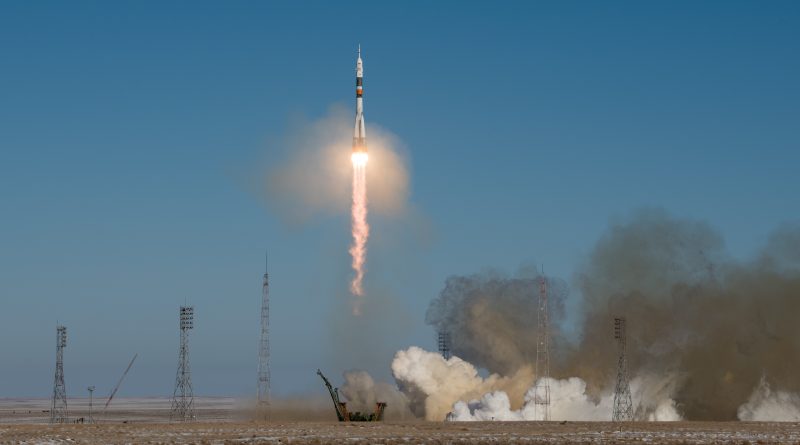Soyuz Rocket Braves Freezing Temperatures, Sends Next Space Station Crew to Orbit
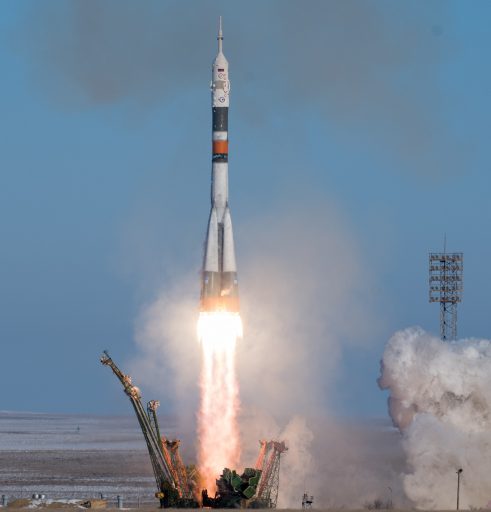
Three crewmen from Russia, the U.S. and Japan blasted off in freezing temperatures on Sunday to set sail on a two-day rendezvous with the International Space Station to kick off a half-year mission living and working in space to conduct world-class science and outfit the orbital outpost for operations heading into the next decade.
Third-time Soyuz Commander Anton Shkaplerov, former Navy Test Pilot Scott Tingle and physician-astronaut Norishige Kanai climbed atop 274 metric tons of explosive rocket propellants on a frigid Sunday afternoon at Kazakhstan’s Baikonur Cosmodrome to begin the final countdown to their launch on a 168-day mission. The trusted Soyuz FG rocket, making its 62nd launch on Sunday, roared to life when its engines spun up their turbopumps and overcame counterweights to lift the 49.5-meter tall vehicle off the ground with a thrust exceeding 420 metric tons.
Soyuz FG took flight at 7:21 UTC, 1:21 p.m. local time, arcing into crystal clear skies over the historic launch base to send the 7,200-Kilogram Soyuz MS-07 spacecraft into a 200-Kilometer orbit to begin its chase of the International Space Station. The raw power of rocket engines transitioned to the sensation of zero-gravity for the experienced Soyuz commander and his rookie flight engineers when Soyuz shut down its engines and sent the spacecraft on its way nine minutes after liftoff.
If all goes well, Soyuz MS-07 will be inbound for an automated docking maneuver to the Space Station’s Rassvet module at 8:43 UTC on Tuesday to deliver the second half of the Expedition 54 crew to their home in space.
Sunday’s launch was the fourth and final human launch of 2017 and the 85th overall this year, the 15th for the Soyuz family.
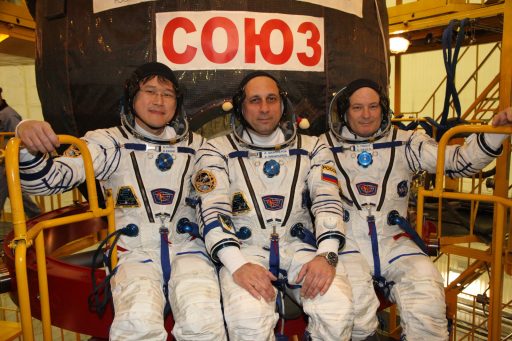
The launch of the 136th Soyuz mission comes in a very busy time for ISS vehicle traffic with Soyuz MS-05 landing on the frozen steppe of Kazakhstan on Thursday and the 13th operational Dragon spacecraft taking flight from Florida on Friday for a robotic capture only a few hours after Soyuz MS-07 lifted off.
Soyuz MS-07 was originally scheduled to launch on December 27 based on the orbital dynamics requirements for a same-day launch-and-docking, specifically the combination of the planar launch window with a narrow phase angle corridor, placing Soyuz close to the Space Station at the point of orbital insertion. Liftoff was brought forward by ten days at the request of NASA to de-conflict with the upcoming holidays in order to avoid having personnel at Baikonur or in transit, coming at the cost of losing the same-day rendezvous.
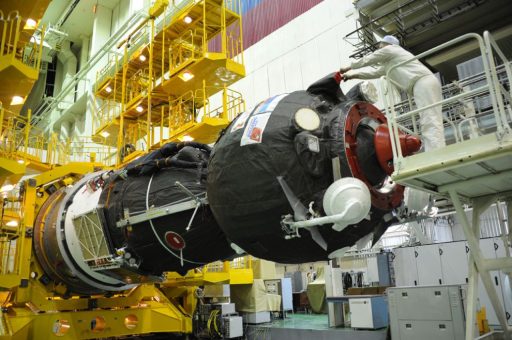
However, a benefit of a rapid-fire crew rotation with one Soyuz departing and another arriving five days later is a shortened three-crew operations phase aboard ISS, allowing more science to be completed with additional hands arriving earlier.
The majority of the crew’s time in orbit will be dedicated to scientific experiments with over 320 studies in progress during their tenure. For many of them, the crew members themselves will act as test subjects to learn about the effects of the space environment on different bodily systems – knowledge that is required to achieve longer and longer mission durations through the implementation of improved countermeasures preventing the negative effects of space radiation and microgravity-induced bone & muscle loss.
The Expedition 54/55 crew will also oversee four visiting vehicle arrivals and support up to five spacewalks to complete external maintenance on the Station’s robotic arm and other external outfitting tasks.
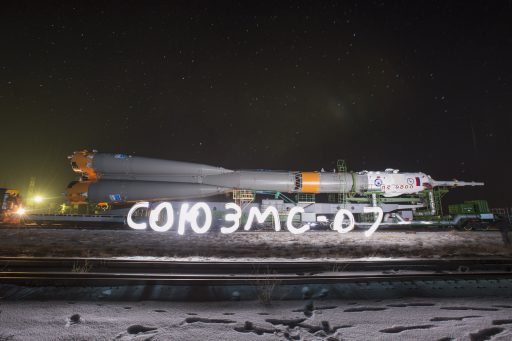
Soyuz MS-07, carrying the call sign Astrey, is Anton Shkaplerov’s third mission as commander after he served in this position for the Soyuz TMA-22 and TMA-15M missions in 2011 and 2014, raking up a total of 365 days spent in space on two long-duration ISS flights. Shkaplerov was selected as a Cosmonaut Candidate in 2003 after serving as a fighter pilot, pilot instructor and parachute instructor in the Russian Air Force.
The Soyuz left seater, considered the co-pilot position, is NASA’s Scott Tingle, a former naval aviator who served in active combat operations and as a test pilot between 1991 and 2009 when he was selected by NASA. In a supporting position from the right seat is Japanese astronaut Norishige Kanai, a former medical doctor serving in the Japanese Defence Forces where he looked after the wellbeing of deep sea divers until a surprise selection by JAXA in 2009 led to a fast career change for him.
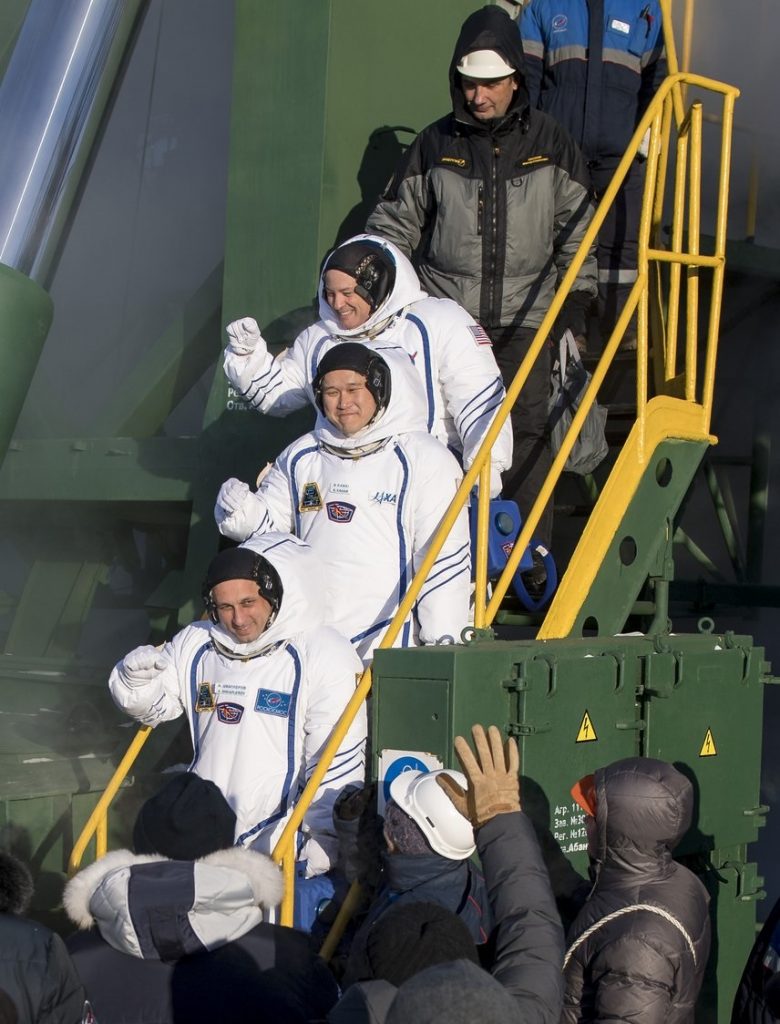
The crew’s long launch day started around nine hours before liftoff with the typical routine of a last shower in the comforts of gravity and having breakfast at the Cosmonaut Hotel before receiving the traditional blessing when departing for Site 254 of the Cosmodrome. There, the three crewmen donned their Sokol Launch and Entry Suits and had the chance of a final face-to-face conversation with friends and family members while also undergoing leak checks on their suits before departing for the Site 1/5 launch pad that has been the primary on-ramp to space for crewed missions from Baikonur for over five decades.
Out at Site 1/5, also known as “Gagarin’s Start,” teams initiated countdown operations at T-8 hours with several hours of testing and tanking preparations. The Russian State Commission provided the go-ahead for fueling after its final pre-launch meeting and engineers at the pad put the tanking sequence in motion at the T-5-hour mark. Over the course of two hours, Soyuz received 274,140 Kilograms of Kerosene fuel and -183°C Liquid Oxygen oxidizer plus Liquid Nitrogen to act as tank pressurization gas.
Two and a half hours before launch, the bus with the three Soyuz crew members pulled into the ‘Dangerous Zone’ of Site 1/5, giving the crew their first and last chance to marvel at their fully-fueled rocket. Waving good bye from the Service Structure, the crew was taken up 15 stories to their Soyuz spacecraft to enter their seats for a final hour of pre-launch setup including leak checks on the capsule. Soyuz was revealed 40 minutes ahead of launch when the Service Structure halves opened up and lowered to their launch position to clear the way for the 305-metric ton rocket.
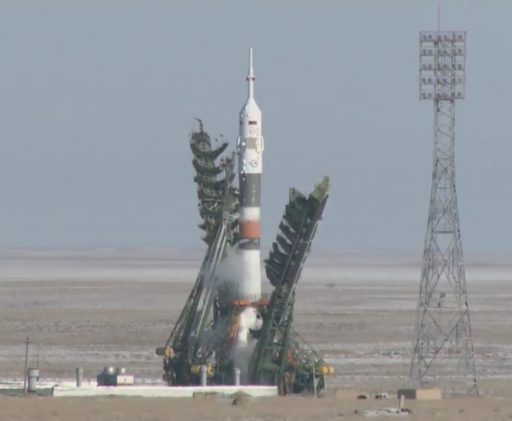
As clocks ticked down, the crew was entertained with music after finishing their part of the pre-launch checklist to configure Soyuz for liftoff. Soyuz MS-07 was switched to battery power and the final roll call by the team in the Launch Bunker gave the GO for the Automated Countdown Sequence six minutes prior to launch. Dating back to its ICBM roots, Soyuz still uses a physical launch key that was inserted inside the Launch Bunker to signal final launch authorization.
Soyuz moved through a choreographed series of steps to pressurize its tanks, configure its guidance system for flight and purge the engines with inert nitrogen to ensure a clean ignition. At the one-minute mark, Soyuz was switched to internal power and assumed full control of the countdown as the upper umbilical mast retracted from the rocket. The Launch Command was issued at T-20 seconds, initiating the spin-up of turbopumps and ignition of the RD-107A and RD-108A four-chamber engines on the boosters and the core.
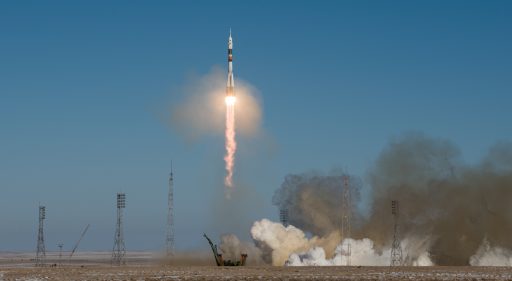
Flames erupted from the base of the rocket as the engines soared to a preliminary thrust stage before ramping up to a collective launch thrust of 422 metric-ton-force to overcome counterweights and lift the vehicle off the ground. Soyuz lifted off at precisely 7:21:01.127 UTC, climbing away from its historic launch pad that was supporting its 509th mission on Sunday.
With over 1,800 missions under its belt over a career of five decades, Soyuz is unmatched in the world of rocketry both in terms of flight heritage and reliability. Built on the R7 design envisioned by Sergei Korolev, Soyuz can support crewed missions, logistics flights and satellite launches to all types of orbits.
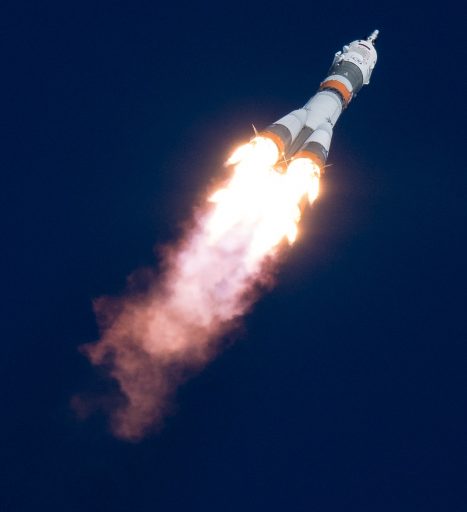
Roaring into clear skies over Baikonur, Soyuz pitched over to start heading to the north east toward the Russian-Kazakh border, aligning itself with the standard departure route for ISS flights departing Baikonur. Soyuz consumed 1,600 Kilograms of propellant each second of powered flight as its boosters and core stage pushed the vehicle through the sound barrier one minute after liftoff.
The SAS Launch Escape Tower was jettisoned one minute and 54 seconds into the flight, quickly followed by the shutdown and separation of the four liquid-fueled boosters when exhausting their 39,600-Kilogram propellant supplies. Having helped accelerate Soyuz to a speed of 1.5 Kilometers per second, the four 19.6-meter long boosters were jettisoned at T+1 minute and 58 seconds, pushed outward and away from the still-firing core stage.
With the boosters heading for a crash landing some 350 Kilometers from the launch pad, Soyuz continued speeding towards orbit under the power of its core stage alone, generating a vacuum thrust of 102,000 Kilogram-force. By two minutes and 37 seconds into the flight, Soyuz had reached 85 Kilometers in altitude and separated its launch shroud to shed no-longer-needed weight and give the two first-time fliers in the outer seats their first view of Earth’s curvature and thin atmosphere.
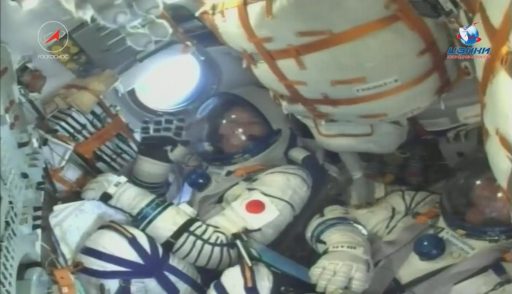
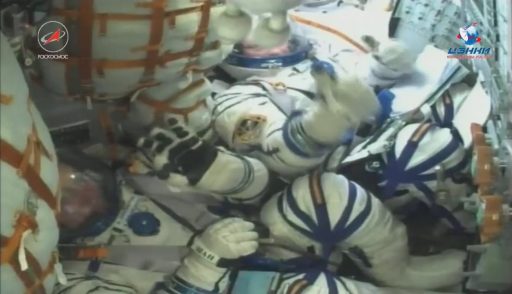
After G forces peaked just before separation of the boosters, Gs again climbed for the crew as the core stage approached the end of its burn, pushing them into their seats with nearly four times their body weight. Onboard cameras showed the crew being thrown forward when the core stage shut down its engine four minutes and 45 seconds into the flight after lifting Soyuz to an altitude of 140 Kilometers and accelerating it to 3.7 Kilometers per second.
Having consumed 91 metric tons of propellant, the 27.8-meter long Core Stage was jettisoned via cutting charges moments after the Block I third stage fired up its RD-0110 engine for the final push into orbit. As the core headed for an impact 1,500 Kilometers from Baikonur, Block I jettisoned its aft section covers to fully expose its engine section as it began a four-minute burn to speed up the stack by another four Kilometers per second.
Calls made from the launch bunker indicated Soyuz was performing nominally throughout the burn of the 30,400-Kilogram-force engine, burning nearly 23 metric tons of propellant to boost Soyuz into orbit, targeting the typical injection orbit of 200 by 242 Kilometers, matching the Space Station’s 51.6-degree inclination.
Onboard cameras showed the familiar jolt eight minutes and 45 seconds into the flight when the acceleration of launch suddenly faded into the sensation of microgravity, also evidenced by the Zero-G mascot suspended in the Soyuz. Separation of the Soyuz spacecraft was confirmed three seconds after engine cutoff and only a few seconds later, the spacecraft executed time-tagged commands and deployed its solar arrays and navigation antennas.
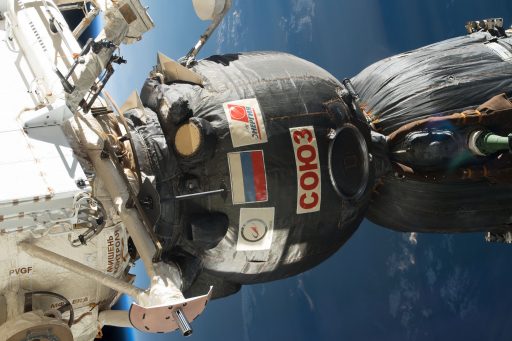
Now in control of the flight, Mission Control Moscow closely watched over the critical deployment events and the pressurization of the craft’s Unified Propulsion System in preparation for DPO thruster activation to stabilize the craft in an optimized orientation for power generation. Before heading out of ground station range, the crew was given a GO to open their helmets and complete their flight plan as written.
Sticking to the two-day rendezvous profile, Soyuz will execute a pair of SKD main engine firings on its third lap around the planet to lift its orbit closer to the Station’s 400-Kilometer altitude. Afterwards, the crew will be able to remove their suits, have dinner and head into their first of two nights aboard the Soyuz on Orbit #6. Monday is dedicated to a Manual Attitude Control test performed by Commander Shkaplerov and a small orbit adjustment on Orbit #17 to correctly position Soyuz for the Automated Rendezvous Sequence starting Tuesday morning.

